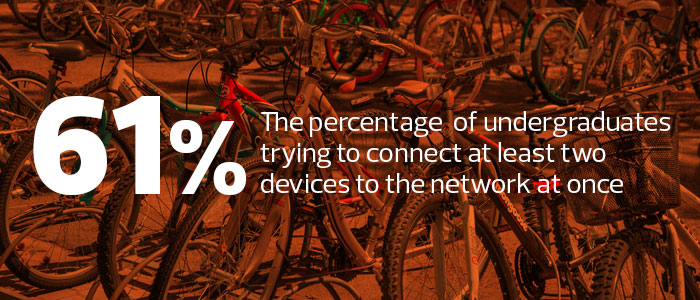Colleges Ready Wireless Networks for Students Who Aren’t Even on Campus Yet
Wireless connectivity was a long time coming to student residences at the University of California, Irvine. UCI, with 32,000 students, became the last of the University of California’s 10 campuses to bring Wi-Fi to its dorms in the fall of 2015.
“The project was really driven by student demands and complaints,” says Kevin Ansel, until recently the director of student affairs IT. “It increased to a critical mass over time.”
Administrators knew the lack of Wi-Fi in residence halls was undermining UCI’s efforts to compete with other institutions for talented, tech-savvy students. To fix the issue, the university researched “the latest and greatest technology” that would meet student needs for years to come, says Ansel.

SOURCE: EDUCAUSE Center for Analysis and Research, “Undergraduate Students and IT, 2015,” December 2015
Upgrading Is A Team Effort
UCI, a longtime Cisco Systems shop, upgraded its wired network to support the new wireless infrastructure. Then the university installed 1,315 Cisco 3702i access points in residence halls, with Cisco Catalyst switches at the network’s edge. The network supports the 802.11ac wireless standard, which provides higher throughput speeds and the capacity to connect more devices than earlier versions of the protocol. Both factors are critical as students bring multiple devices to campus and demand high performance on all of them at once. By intention, the environment will grow along with UCI’s mobile technology needs, says Ansel.
“We worked with CDW to put in a state-of-the-art system that’s going to hold us for many, many years,” he says. “When we designed it, we said, ‘Picture five years from now when students are showing up with more wireless devices than they’ve got now. Are they going to be coming with some technology that isn’t invented yet? Are they going to have wireless ballpoint pens?’ Who knows? But we needed to think ahead, so we built a system that is very robust.”
Given the rapid increase in bandwidth demand in recent years, UCI was able to upgrade its wireless network with eyes wide open to the necessity of future-proofing. Many colleges and universities, however, are strategizing on how to adapt an existing wireless network.
Assembling Stakeholders Is Key
James Wiley, a principal analyst at Eduventures, says that institutions should start by assembling a team that can assess the current wireless network and create a vision of one that could accommodate future demands.
“You need a group of people who can piece together an accurate, detailed picture of where you are now, can envision what the future is going to look like and can connect the dots between them,” Wiley says. “Finding those people and bringing the group together is a big challenge.”
Although IT has a crucial role in the process, the team has to include stakeholders from every corner of the institution, including technical and nontechnical players from instructional, administrative and facilities management departments, for example.
“Networks are not just plumbing,” says Wiley. “The group will be making decisions to support institutional goals. And for a project like this to work, you need champions outside of IT.”
Forward-looking plans should describe both current and envisioned networks in detail, addressing issues such as coverage, security, reliability, usability and ease of management, and bandwidth, Wiley says.
With that information, planners can consider strategies for achieving a network for the future. They can then weigh options in terms of cost and potential trade-offs in risk or performance.
The process of assessing and then upgrading wireless capabilities can be difficult and time consuming, and it requires skills that lean college IT staffs may not have. Consultants or contract services can eliminate near-term headaches and secure long-term benefits, Wiley says. “Institutions with the most high-functioning IT departments might be able to do it themselves, but most would be wise to invest in some outside support.”
Upgrading From The Inside–Out
When Michael Spande became the director of enterprise infrastructure at Bethel University in St. Paul, Minn., three years ago, he was immediately concerned about the institution’s wireless network. It was unreliable and hard to maintain. Spande was also skeptical of the network’s capacity to serve existing Wi-Fi needs, and he knew it wouldn’t carry the growing university into the future. Bethel, an Evangelical Christian university, enrolls approximately 6,000 students.
“The wireless network was one of my highest priorities when I came to the job. It was aging, and we were having lots of outages,” says Spande. “I didn’t have confidence in its stability, and I knew we needed to make a change.”
Because of Bethel’s small IT staff, Spande turned to CDW Managed Services for the expertise he needed to replace the old network and manage a new one. CDW ripped out the old infrastructure and replaced it with Cisco hardware and software, placing 450 access points across the campus, backed by new Cisco switches.
“We knew we had to start from the inside out and get the switching backbone we needed to build the wireless network we needed,” Spande says. “You can have the best APs in the world and good coverage, and your network still won’t perform well without high-performance switches.”
Today, the Bethel network is, for the first time, monitored and managed around-the-clock by CDW Managed Services. With the new network, wireless coverage and bandwidth inside campus buildings have gone from unreliable to rock-solid, says Spande. The IT staff, along with CDW, has begun work on boosting outdoor coverage, with improvements in the football stadium and some parking lots already in place, he says.
Most important, the new wireless infrastructure, with its high-end Cisco hardware and software and managed upgrades, should meet the university’s bandwidth needs for years to come.
“With more flexibility and more horsepower on the back end, we now have room to improve the network as students bring more devices and APs require more bandwidth,” says Spande.

Chris Bohnhoff
Meeting Growing Demand
Like their counterparts in other colleges, students at Thomas College in Waterville, Maine, have an “almost insatiable” demand for wireless bandwidth, says CIO Chris Rhoda. And the administrative leadership at Thomas, a private institution with approximately 1,000 students, has indicated that Wi-Fi is a top priority because of its great importance to students.
“Students are bringing three or four devices, they expect to be connected all the time, and that connection for them is primarily over Wi-Fi,” says Rhoda.
Evolving wireless technology is just as hard to keep up with as students’ appetite for bandwidth, says Rhoda. New versions of the 802.11 wireless protocol are released almost annually, and new services and devices appear at a dizzying rate. On top of that, IT has to provide wireless connectivity for both older or inexpensive devices and the newest technology.
Setting A Realistic Refresh Cycle
Rhoda and his staff respond to these demands with scheduled upgrades, and recognition that the need to increase network capacity and coverage is inevitable and ongoing. The college has an Adtran Bluesocket cloud-managed wireless infrastructure that, in addition to scalability, offers network monitoring and reporting without funneling traffic through a centralized point. As part of a four-year refresh cycle, IT is now upgrading 25 percent of the network hardware by replacing older APs with 50 new Adtran Bluesocket wireless APs that deliver 802.11ac connectivity.
“I think of wireless in a four-year window because that’s about the limit of how far ahead we can see,” says Rhoda. “I don’t put wireless hardware in place today and expect it to be here in five years. Things change too quickly.”
Wired connections live on mainly in the college’s administrative and faculty offices, but wireless is the present and future of the network from a student perspective, in both residence halls and classrooms, Rhoda says.
“When our students think of IT on campus, they judge that by how good the Wi-Fi is,” he says. “With that in mind, we allocate significant resources to make sure it’s good and stays that way.”
Bethel University’s Spande would agree. “We want to listen to our students, but we also have no choice,” he says. “People pick their colleges based on factors like how good the wireless network is. They share their experiences online, and we can either look good or have a big black eye.”








